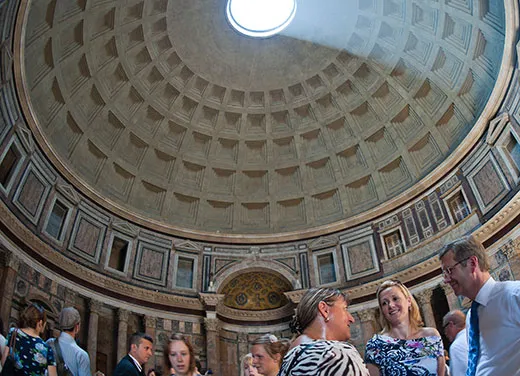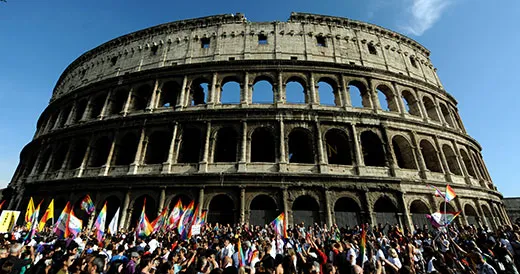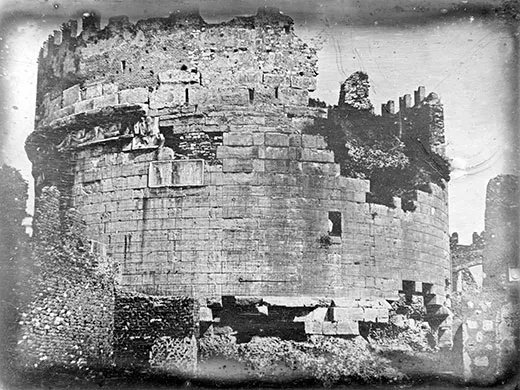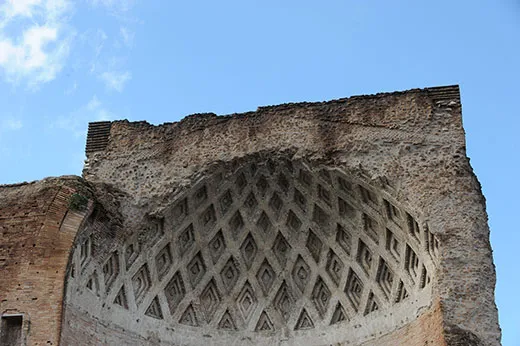The Secrets of Ancient Rome’s Buildings
What is it about Roman concrete that keeps the Pantheon and the Colosseum still standing?
/https://tf-cmsv2-smithsonianmag-media.s3.amazonaws.com/filer/Roman-cement-Colosseum-631.jpg)
The Romans started making concrete more than 2,000 years ago, but it wasn’t quite like today’s concrete. They had a different formula, which resulted in a substance that was not as strong as the modern product. Yet structures like the Pantheon and the Colosseum have survived for centuries, often with little to no maintenance. Geologists, archaeologists and engineers are studying the properties of ancient Roman concrete to solve the mystery of its longevity.
“Roman concrete is . . . considerably weaker than modern concretes. It’s approximately ten times weaker,” says Renato Perucchio, a mechanical engineer at the University of Rochester in New York. “What this material is assumed to have is phenomenal resistance over time.”
That resistance, or durability against the elements, may be due to one of the concrete’s key ingredients: volcanic ash. Modern concrete is a mix of a lime-based cement, water, sand and so-called aggregates such as fine gravel. The formula for Roman concrete also starts with limestone: builders burned it to produce quicklime and then added water to create a paste. Next they mixed in volcanic ash—usually three parts volcanic ash to one part lime, according to the writings of Vitruvius, a first-century B.C. architect and engineer. The volcanic ash reacted with the lime paste to create a durable mortar that was combined with fist-size chunks of bricks or volcanic rocks called tuff, and then packed into place to form structures like walls or vaults.
By the beginning of the second century B.C., the Romans were already using this concrete in large-scale construction projects, suggesting their experimentation with the building material began even earlier. Other ancient societies such as the Greeks probably also used lime-based mortars (in ancient China, sticky rice was added for increased strength). But combining a mortar with an aggregate like brick to make concrete was likely a Roman invention, Perucchio says.
In the earliest concretes, Romans mined ash from a variety of ancient volcanic deposits. But builders got picky around the time Augustus became the first Roman emperor, in 27 B.C. At that time, Augustus initiated an extensive citywide program to repair old monuments and erect new ones, and builders exclusively used volcanic ash from a deposit called Pozzolane Rosse, an ash flow that erupted 456,000 years ago from the Alban Hills volcano, 12 miles southeast of Rome.
“Emperor Augustus was the driving force behind the systemization, standardization of mortar mixes with Pozzolane Rosse,” says Marie Jackson, a geologist and research engineer at the University of California at Berkeley. Roman builders likely favored the ash deposit because of the durability of concrete made with it, she adds. “This was the secret to concretes that were very well bonded, coherent, robust materials.”
Jackson and her colleagues have been studying the chemical composition of concretes made with Pozzolane Rosse. The ash’s unique mix of minerals appears to have helped the concrete withstand chemical decay and damage.
The Romans favored another specific volcanic ash when making concrete harbor structures that were submerged in the salty waters of the Mediterranean. Pulvis Puteolanus was mined from deposits near the Bay of Naples. “The Romans shipped thousands and thousands of tons of that volcanic ash around the Mediterranean to build harbors from the coast of Italy to Israel to Alexandria in Egypt to Pompeiopolis in Turkey,” Jackson says.
Seawater is very damaging to modern concrete. But in Roman concrete, the Pulvis Puteolanus “actually plays a role in mitigating deterioration when water percolates through it,” Jackson says. Although the exact mechanism is unknown, it appears that chemical reactions among the lime paste, volcanic ash and seawater created microscopic structures within the concrete that trapped molecules like chlorides and sulfates that harm concrete today.
Despite the success of Roman concrete, the use of the material disappeared along with the Roman Empire. Concrete structures were seldom built during the Middle Ages, suggesting volcanic ash wasn’t the only secret to the durability of Roman concrete, Perucchio says. “These really large projects could only be done with the appropriate bureaucracy, with the proper organization that the Roman Empire would provide.”
Erin Wayman is an assistant editor at Smithsonian and writes the Hominid Hunting blog.
/https://tf-cmsv2-smithsonianmag-media.s3.amazonaws.com/accounts/headshot/science-erin-wyman-240.jpg)




/https://tf-cmsv2-smithsonianmag-media.s3.amazonaws.com/accounts/headshot/science-erin-wyman-240.jpg)